View in other NatureServe Network Field Guides
NatureServe
Montana
Utah
Wyoming
Idaho
Wisconsin
British Columbia
South Carolina
Yukon
California
New York
Sprague's Pipit - Anthus spragueii
State Rank Reason (see State Rank above)
Species appears to be declining in Montana and faces threats from native habitat loss and fragmentation due row crop conversion, overgrazing, exotic plant invasions, altered fire regimes, and mowing prior to fledging of young.
General Description
The adult Sprague's Pipit is a pale, slender, sparrow-sized bird with white outer tail feathers, a thin bill, pale legs, and a heavily streaked back. Adults reach a length of 6.5 inches (16.5 cm), with a wingspan of 10 inches (25.4 cm), and a weight of 23.7 to 24.0 grams. The sexes are alike. The sides of the head and indistinct buffy eye-rings are pale. The lores contrast with dark brown eyes and the ear coverts are plain brownish-buff, usually with a slight reddish tinge. The crown, sides and rear of neck are buffy with sharply defined black streaks. The back is light sandy-brown with broad black streaks, with a paler more prominent buffy stripe down each side. The wings, 7.7 to 8.5 cm long, have blackish-brown feathers with whitish to buffy-brown edging, and two whitish wing bars. The rump and upper tail coverts, paler than the back, are sandy-brown with narrow black streaks. The blackish-brown feathers of the tail have buffy edging and the outer two pairs of feathers are white. The breast is a bright dark buff with a necklace of narrow black streaks. The flanks are brownish-buff and without streaks. The legs of the adults are pale brown, flesh or yellowish-brown, while they are pinkish in the juveniles (Godfrey 1966, Maher 1979, King 1981, Robbins and Dale 1999).
On the ground, the bird is extremely secretive and flies away in a long, undulating flight when approached. It walks instead of hops and usually only lands on the ground. The bird is most easily detected by its unique flight song given high overhead (as high as 75 meters); a high-pitched, thin "jingling" sound that can continue for as long as an hour (Peterson 2002, King 1981). Johnsgard (1992) notes that the species' spectacular circular song-flight display around its territory, during which its white outer tail feathers are conspicuously spread, compensates for its particularly inconspicuous plumage.
For a comprehensive review of the conservation status, habitat use, and ecology of this and other Montana bird species, please see
Marks et al. 2016, Birds of Montana.Diagnostic Characteristics
The buffy-brown back with blackish streaking, white wing bars, dark streaked crown, and pale legs distinguish this pipit from the American Pipit, the other species with whom its plumage is most similar (Robbins and Dale 1999, Sibley 2000). Additional characteristics identifying Sprague's Pipit include pale buffy to whitish ear coverts, extensive white on the outer tail feathers, a pale lower mandible, a darker upper mandible, and a diagnostic single-syllable, squeaky, quick call (Robbins and Dale 1999, Sibley 2000). While the Sprague's Pipit is a species of the prairie, the American Pipit typically favors wetter areas and perches more conspicuously (on fences, telephone wires, and treetops) than the Sprague's Pipit (Robbins and Dale 1999).
Species Range
Montana Range
Range Descriptions
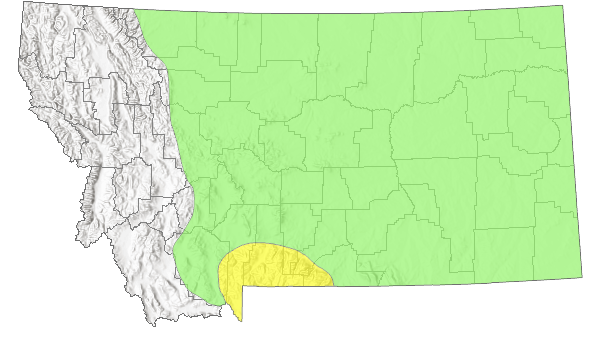 Western Hemisphere Range
Western Hemisphere Range

Observations in Montana Natural Heritage Program Database
Number of Observations: 6669
(Click on the following maps and charts to see full sized version)
Map Help and Descriptions
Relative Density
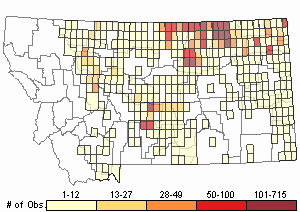
Recency
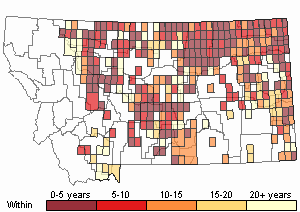
SUMMER (Feb 16 - Dec 14)
Direct Evidence of Breeding

Indirect Evidence of Breeding

No Evidence of Breeding

WINTER (Dec 15 - Feb 15)
Regularly Observed

Not Regularly Observed

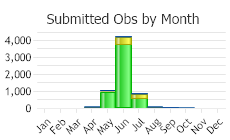
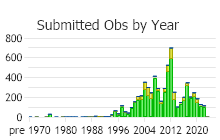
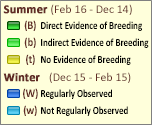 (Observations spanning multiple months or years are excluded from time charts)
(Observations spanning multiple months or years are excluded from time charts)
Migration
The Sprague's Pipit arrives in Montana in early May and breeds shortly thereafter. Records indicate eggs are present in May at Bowdoin National Wildlife Refuge (Montana Bird Distribution Committee 2012). Fall migration begins at the end of August. Few records exist for the species in Montana outside of the May to August time period. The extreme migration dates for the species are April (Roosevelt County) and October (Stillwater County) and are represented by only two records (Montana Bird Distribution Committee 2012).
Habitat
An endemic grassland bird, the Sprague's Pipit prefers native, medium to intermediate height prairie (Casey 2000) and in a short grass prairie landscape, can often be found in areas with taller grasses (Samson and Knopf 1996). The Sprague's Pipit is significantly more abundant in native prairie than in exotic vegetation (Dechant et al. 2001). Dechant (2001) also notes that the species has been shown to be area sensitive, requiring relatively large areas of appropriate habitat; the minimum area requirement in a Saskatchewan study was 190 hectares (470 acres). This pipit is also known to utilize and breed in alkaline meadows and around the edges of alkaline lakes (Johnsgard 1992).
National Vegetation Classification System Groups Associated with this Species
Grassland
Lowland - Prairie Grassland
Wetland and Riparian
Alkaline - Saline Wetlands
Peatland
Riparian and Wetland Forest
Riparian Shrubland
Wet Meadow and Marsh
Recently Disturbed or Modified
Introduced Vegetation
Food Habits
No information on food habits for Sprague's Pipit exists for Montana. However, studies of Sprague's Pipit outside Montata state the primary summer food item is insects, while seeds are consumed during the fall and winter. The Sprague's Pipit is a ground forager. Adults eat a variety of seeds and insects such as grasshoppers, crickets, ants, weevils, stink bugs and caterpillars (Bent 1950). A Manitoba study revealed that nestlings were fed grasshoppers, crickets and moths (Harris 1933) while in an Alberta study, the items of choice for nestlings were grasshoppers, leafhoppers, caterpillars and ants (Maher 1979).
Ecology
No ecological information exists for Sprague's Pipit in the state. Other studies indicate small territories in presumably good habitat are on the order of 1 hectare in size (Robbins and Dale 1999). Brood parasitism by Brown-headed Cowbirds is documented in Saskatchewan and Manitoba, where rates of parasitism ranged from zero to 25 percent (Dechant et al. 2001).
Reproductive Characteristics
Active Sprague's Pipit nests have been recorded from May through August, with clutch sizes ranging from 3 to 6. Egg dates are probably similar to those for North Dakota: June 7 to 30. The species breeds regularly at Bowdoin National Wildlife Refuge in Phillips County, locations in Valley and Sheridan counties, and regularly in other counties in the eastern portion of the state with appropriate mixed-grass habitat (Montana Bird Distribution Committee 2012). In other portions of its range, studies indicate the nests are located in depressions in the ground and concealed in clumps of grass (Terres 1980). They are constructed entirely of dead grass, and woven in a circular arrangement; no lining is present (Roberts 1932, Bent 1950). Some nests are partially or completely arched over with dead grasses anchored to the surrounding vegetation. In Manitoba, a nest was built in a depression that was much larger than the nest itself and the extra space was filled with dead grass (Harris 1933). The interior of this nest measured three inches (7.6 cm) in diameter and was 1.5 inches (3.5 cm) deep. Nests are difficult to find, and females do not flush from the nest until they are almost stepped on. Nestlings are altricial and downy.
The eggs are a dull grayish-white with little or no gloss and are speckled with spots or blotches of purplish-brown, with the markings being more numerous at the large end. The average measurement of 44 eggs from various locations was 20.9 by 15.3 mm (Bent 1950). Clutch size is usually four or five eggs; occasionally three to six eggs. The incubation period is unknown, but the Meadow Pipit (Anthus pratensis) in Europe has an incubation period of 13 to 14 days (Bent 1950), and the Sprague's Pipit's is presumed to be of similar duration (Baicich and Harrison 2005).
There seems to be a period of inactivity between an active period of breeding behavior in late April to early June and a late period from mid-July through early September (Stewart 1975). Therefore, although it has never been documented, Sprague's Pipits may raise two broods of young a year.
The female did all of the brooding and feeding of the nestlings in a nest in Manitoba (Harris 1933). These nestlings stayed in the nest 10 or 11 days and when they left, they were not able to fly and had difficulty standing upright. The male may do most of the feeding of the young after they leave the nest, especially in the early part of the breeding season (Harris 1933). In Saskatchewan, the dates that young leave the nest range from the end of May to the middle of August, with the median date occurring at the end of June (Maher 1979).
Management
On April 5, 2016, the U.S. Fish and Wildlife Service determined that listing the Sprague’s Pipit as an endangered or threatened species was not warranted throughout all or a significant portion of its range and removed the species from candidate status. Additional information on the species' management can be found on the U.S. Fish and Wildlife Service's
Species AccountStewardship Responsibility
References
- Literature Cited AboveLegend:
 View Online Publication
View Online Publication Baicich, P.J. and C.J.O. Harrison. 2005. A guide to the nests, eggs and nestlings of North American birds. Second edition. Academic Press, New York.
Baicich, P.J. and C.J.O. Harrison. 2005. A guide to the nests, eggs and nestlings of North American birds. Second edition. Academic Press, New York. Bent, A.C. 1950. Life histories of North American wagtails, shrikes, vireos, and their allies. U.S. National Museum Bulletin 197. Washington, D.C.
Bent, A.C. 1950. Life histories of North American wagtails, shrikes, vireos, and their allies. U.S. National Museum Bulletin 197. Washington, D.C. Casey, D. 2000. Partners in Flight Bird Conservation Plan Montana Version 1.0. Montana Partners in Flight. Kalispell, Montana.
Casey, D. 2000. Partners in Flight Bird Conservation Plan Montana Version 1.0. Montana Partners in Flight. Kalispell, Montana. Dechant, J. A., M. L. Sondreal, D. H. Johnson, L.D. Igl, C. M. Goldade, M. P. Nenneman, and B. R. Euliss. 2001. Effects of management practices on grassland birds: Sprague’s pipit. Northern Prairie Wildlife Research Center, Jamestown, ND. Northern Prairie Wildlife Research Center.
Dechant, J. A., M. L. Sondreal, D. H. Johnson, L.D. Igl, C. M. Goldade, M. P. Nenneman, and B. R. Euliss. 2001. Effects of management practices on grassland birds: Sprague’s pipit. Northern Prairie Wildlife Research Center, Jamestown, ND. Northern Prairie Wildlife Research Center. Godfrey, W. Earl. 1966. The birds of Canada. National Museums of Canada, Ottawa. 428 pp.
Godfrey, W. Earl. 1966. The birds of Canada. National Museums of Canada, Ottawa. 428 pp. Harris, R. D. 1933. Observations on a nest of Sprague's pipit (Anthus spragueii). Canadian Field-Naturalist 47:91-5.
Harris, R. D. 1933. Observations on a nest of Sprague's pipit (Anthus spragueii). Canadian Field-Naturalist 47:91-5. Johnsgard, P.A. 1992. Birds of the Rocky Mountains with particular reference to national parks in the northern Rocky Mountain region. Lincoln: University of Nebraska Press. xi + 504 pp.
Johnsgard, P.A. 1992. Birds of the Rocky Mountains with particular reference to national parks in the northern Rocky Mountain region. Lincoln: University of Nebraska Press. xi + 504 pp. King, B. 1981. The field identification of North American pipits. American Birds 35:778-88.
King, B. 1981. The field identification of North American pipits. American Birds 35:778-88. Maher, W.J. 1979. Nestling diets of prairie passerine birds at Matador, Saskatchewan, Canada. Ibis 121:437-452.
Maher, W.J. 1979. Nestling diets of prairie passerine birds at Matador, Saskatchewan, Canada. Ibis 121:437-452. Marks, J.S., P. Hendricks, and D. Casey. 2016. Birds of Montana. Arrington, VA. Buteo Books. 659 pages.
Marks, J.S., P. Hendricks, and D. Casey. 2016. Birds of Montana. Arrington, VA. Buteo Books. 659 pages. Montana Bird Distribution Committee. 2012. P.D. Skaar's Montana bird distribution. 7th Edition. Montana Audubon, Helena, Montana. 208 pp. + foldout map.
Montana Bird Distribution Committee. 2012. P.D. Skaar's Montana bird distribution. 7th Edition. Montana Audubon, Helena, Montana. 208 pp. + foldout map. Peterson, R.T. 2002. A field guide to the birds of eastern and central North America. Fifth Edition. Houghton Mifflin Company. Boston, MA.
Peterson, R.T. 2002. A field guide to the birds of eastern and central North America. Fifth Edition. Houghton Mifflin Company. Boston, MA. Roberts, T. S. 1932. The birds of Minnestoa. Vol. 2. University of Minnesota Press, Minneapolis, Minnesota. 821 pp.
Roberts, T. S. 1932. The birds of Minnestoa. Vol. 2. University of Minnesota Press, Minneapolis, Minnesota. 821 pp. Samson, F. and F. Knopf. 1996. Prairie conservation – preserving North America’s most endangered ecosystem. Island Press, Washington, D.C. 339 pp.
Samson, F. and F. Knopf. 1996. Prairie conservation – preserving North America’s most endangered ecosystem. Island Press, Washington, D.C. 339 pp. Sibley, D.A. 2000. The Sibley guide to birds. National Audubon Society and Alfred A. Knopf, Inc., New York, NY. 544 pp.
Sibley, D.A. 2000. The Sibley guide to birds. National Audubon Society and Alfred A. Knopf, Inc., New York, NY. 544 pp. Stewart, R.E. 1975. Breeding birds of North Dakota. Tri-College Center for Environmental Studies, Fargo, North Dakota. 295 pp.
Stewart, R.E. 1975. Breeding birds of North Dakota. Tri-College Center for Environmental Studies, Fargo, North Dakota. 295 pp. Terres, J.K. 1980. The Audubon Society encyclopedia of North American birds. Alfred A. Knopf, New York. 1109 pp.
Terres, J.K. 1980. The Audubon Society encyclopedia of North American birds. Alfred A. Knopf, New York. 1109 pp.
- Additional ReferencesLegend:
 View Online Publication
View Online Publication
Do you know of a citation we're missing? American Ornithologists Union. 1983. Checklist of North American birds, 6th Edition. 877 PP.
American Ornithologists Union. 1983. Checklist of North American birds, 6th Edition. 877 PP. American Ornithologists’ Union [AOU]. 1998. Check-list of North American birds, 7th edition. American Ornithologists’ Union, Washington, D.C. 829 p.
American Ornithologists’ Union [AOU]. 1998. Check-list of North American birds, 7th edition. American Ornithologists’ Union, Washington, D.C. 829 p. Berkey, G. B. 1983. Mixed prairie II. American Birds 37:81.
Berkey, G. B. 1983. Mixed prairie II. American Birds 37:81. Berkey, G. B. 1983. Mixed prairie IV. American Birds 37:82.
Berkey, G. B. 1983. Mixed prairie IV. American Birds 37:82. Bird Conservancy of the Rockies. 2017. Pocket Guide to Northern Prairie Birds. Brighton, CO: Bird Conservancy of the Rockies. 98 p.
Bird Conservancy of the Rockies. 2017. Pocket Guide to Northern Prairie Birds. Brighton, CO: Bird Conservancy of the Rockies. 98 p. Bramblett, R.G., and A.V. Zale. 2002. Montana Prairie Riparian Native Species Report. Montana Cooperative Fishery Research Unit, Montana State University - Bozeman.
Bramblett, R.G., and A.V. Zale. 2002. Montana Prairie Riparian Native Species Report. Montana Cooperative Fishery Research Unit, Montana State University - Bozeman. Casey, D. 2000. Partners in Flight Draft Bird Conservation Plan Montana. Version 1.0. 287 pp.
Casey, D. 2000. Partners in Flight Draft Bird Conservation Plan Montana. Version 1.0. 287 pp. Casey, D. 2005. Rocky Mountain Front avian inventory. Final report. Prepared for the U.S. Fish and Wildlife Service and The Nature Conservancy by the American Bird Conservancy, Kalispell, Montana.
Casey, D. 2005. Rocky Mountain Front avian inventory. Final report. Prepared for the U.S. Fish and Wildlife Service and The Nature Conservancy by the American Bird Conservancy, Kalispell, Montana. Dobkin, D. S. 1992. Neotropical migrant landbirds in the Northern Rockies and Great Plains. U.S.D.A. For. Serv. N. Region Publ. R1-93-34. Missoula, Mont.
Dobkin, D. S. 1992. Neotropical migrant landbirds in the Northern Rockies and Great Plains. U.S.D.A. For. Serv. N. Region Publ. R1-93-34. Missoula, Mont. Dobkin, D.S. 1994. Conservation and management of neotropical migrant landbirds in the Northern Rockies and Great Plains. Univ. Idaho Press, Moscow, Idaho. 220 pp.
Dobkin, D.S. 1994. Conservation and management of neotropical migrant landbirds in the Northern Rockies and Great Plains. Univ. Idaho Press, Moscow, Idaho. 220 pp. Dood, A.R. 1980. Terry Badlands nongame survey and inventory final report. Montana Department of Fish, Wildlife, and Parks and Bureau of Land Management, Helena, MT. 70 pp.
Dood, A.R. 1980. Terry Badlands nongame survey and inventory final report. Montana Department of Fish, Wildlife, and Parks and Bureau of Land Management, Helena, MT. 70 pp. Ehrlich, P., D. Dobkin, and D. Wheye. 1988. The birder’s handbook: a field guide to the natural history of North American birds. Simon and Schuster Inc. New York. 785 pp.
Ehrlich, P., D. Dobkin, and D. Wheye. 1988. The birder’s handbook: a field guide to the natural history of North American birds. Simon and Schuster Inc. New York. 785 pp. Faanes, C. A. 1982. Avian use of Sheyenne Lake and associated habitats in central North Dakota. U. S. Fish and Wildlife Service, Resource Publication No. 144.
Faanes, C. A. 1982. Avian use of Sheyenne Lake and associated habitats in central North Dakota. U. S. Fish and Wildlife Service, Resource Publication No. 144. Faanes, C.A. 1983. Breeding birds of wooded draws in western North Dakota. Prairie Nat. 15(4): 173-187.
Faanes, C.A. 1983. Breeding birds of wooded draws in western North Dakota. Prairie Nat. 15(4): 173-187. Fink, D., K.V. Rosenberg, F.A. La Sorte, M.J. Iliff, C. Wood, and S. Kelling. 2013. Species distribution modeling of priority bird species on Bureau of Land Management lands to determine stewardship responsibility for conservation planning. Ithaca, NY: Cornell Lab of Ornithology. 224 p.
Fink, D., K.V. Rosenberg, F.A. La Sorte, M.J. Iliff, C. Wood, and S. Kelling. 2013. Species distribution modeling of priority bird species on Bureau of Land Management lands to determine stewardship responsibility for conservation planning. Ithaca, NY: Cornell Lab of Ornithology. 224 p. Gillihan, SW. and T. VerCauteren. 2015. Pocket Guide to Prairie Birds. Brighton, CO: Bird Conservancy of the Rockies. 91 p.
Gillihan, SW. and T. VerCauteren. 2015. Pocket Guide to Prairie Birds. Brighton, CO: Bird Conservancy of the Rockies. 91 p. Gniadek, S. 1983. Southwest Glendive Wildlife Baseline Inventory. Miles City, Mont: Bureau of Land Management, Miles City District Office. 56 pp with appendices.
Gniadek, S. 1983. Southwest Glendive Wildlife Baseline Inventory. Miles City, Mont: Bureau of Land Management, Miles City District Office. 56 pp with appendices. Harris, C. G. 1983. Speargrass-junegrass-alkali mixed prairie. American Birds 37:80.
Harris, C. G. 1983. Speargrass-junegrass-alkali mixed prairie. American Birds 37:80. Hays, R., R.L. Eng, and C.V. Davis (preparers). 1984. A list of Montana birds. Helena, MT: MT Dept. of Fish, Wildlife & Parks.
Hays, R., R.L. Eng, and C.V. Davis (preparers). 1984. A list of Montana birds. Helena, MT: MT Dept. of Fish, Wildlife & Parks. Hendricks, P, S. Lenard, and C. Currier. 2012. Grassland Bird Surveys in North Valley County and Northwest Phillips County, Montana: 2011 Summary. Report to the USDI Bureau of Land Management. Montana Natural Heritage Program. Helena, MT. 7pp.
Hendricks, P, S. Lenard, and C. Currier. 2012. Grassland Bird Surveys in North Valley County and Northwest Phillips County, Montana: 2011 Summary. Report to the USDI Bureau of Land Management. Montana Natural Heritage Program. Helena, MT. 7pp. Hendricks, P. 2000. Roadside bird counts on BLM lands in Petroleum and Fergus Counties, Montana. Montana Natural Heritage Program, Helena, MT. 57pp.
Hendricks, P. 2000. Roadside bird counts on BLM lands in Petroleum and Fergus Counties, Montana. Montana Natural Heritage Program, Helena, MT. 57pp. Hendricks, P., G.M. Kudray, S. Lenard, and B.A. Maxell. 2007. A Multi-Scale Analysis Linking Prairie Breeding Birds to Site and Landscape Factors Including USGS GAP Data. Helena, Mont: Montana Natural Heritage Program.
Hendricks, P., G.M. Kudray, S. Lenard, and B.A. Maxell. 2007. A Multi-Scale Analysis Linking Prairie Breeding Birds to Site and Landscape Factors Including USGS GAP Data. Helena, Mont: Montana Natural Heritage Program. Hendricks, P., S. Lenard, C. Currier, and J. Carlson. 2007. Grassland bird surveys in north Valley County, Montana: 2001-2006. Report to the Bureau of Land Management, Glasgow Field Office. Montana Natural Heritage Program, Helena, Montana. 19 pp. plus appendices.
Hendricks, P., S. Lenard, C. Currier, and J. Carlson. 2007. Grassland bird surveys in north Valley County, Montana: 2001-2006. Report to the Bureau of Land Management, Glasgow Field Office. Montana Natural Heritage Program, Helena, Montana. 19 pp. plus appendices. Hendricks, P., S. Lenard, C. Currier, B. A. Maxell, and J. Carlson. 2008. Surveys for grassland birds of the Malta Field Office-BLM, including a seven-year study in north Valley County. Montana Natural Heritage Program, Helena.
Hendricks, P., S. Lenard, C. Currier, B. A. Maxell, and J. Carlson. 2008. Surveys for grassland birds of the Malta Field Office-BLM, including a seven-year study in north Valley County. Montana Natural Heritage Program, Helena. Hendricks, P., S. Lenard, D.M. Stagliano, and B.A. Maxell. 2013. Baseline nongame wildlife surveys on the Fort Peck Indian Reservation. Report to the Assiniboine and Sioux Tribes of the Fort Peck Indian Reservation. Montana Natural Heritage Program, Helena, MT. 83 p.
Hendricks, P., S. Lenard, D.M. Stagliano, and B.A. Maxell. 2013. Baseline nongame wildlife surveys on the Fort Peck Indian Reservation. Report to the Assiniboine and Sioux Tribes of the Fort Peck Indian Reservation. Montana Natural Heritage Program, Helena, MT. 83 p. Hoffmann, R.S. 1960. Summer birds of the Little Belt Mountains, Montana. Missoula, MT: Occasional Papers of Montana State University No. 1. 18 p.
Hoffmann, R.S. 1960. Summer birds of the Little Belt Mountains, Montana. Missoula, MT: Occasional Papers of Montana State University No. 1. 18 p. Johnsgard, P.A. 1979. Birds of the Great Plains: breeding species and their distribution. University of Nebraska Press, Lincoln. 539 pp.
Johnsgard, P.A. 1979. Birds of the Great Plains: breeding species and their distribution. University of Nebraska Press, Lincoln. 539 pp. Johnson, D.H., L.D. Igl, J.A. Dechant, M.L. Sondreal, C.M. Goldade, M.P. Nenneman, and B.R. Euliss. 1998. Effects of management practices on grassland birds: Sprague's pipit. Northern Prairie Wildlife Research Center, Jamestown, ND. 10 pp.
Johnson, D.H., L.D. Igl, J.A. Dechant, M.L. Sondreal, C.M. Goldade, M.P. Nenneman, and B.R. Euliss. 1998. Effects of management practices on grassland birds: Sprague's pipit. Northern Prairie Wildlife Research Center, Jamestown, ND. 10 pp. Joslin, Gayle, and Heidi B. Youmans. 1999. Effects of recreation on Rocky Mountain wildlife: a review for Montana. [Montana]: Montana Chapter of the Wildlife Society.
Joslin, Gayle, and Heidi B. Youmans. 1999. Effects of recreation on Rocky Mountain wildlife: a review for Montana. [Montana]: Montana Chapter of the Wildlife Society. Kantrud, H. A. 1981. Grazing intensity effects on the breeding avifauna of North Dakota native grasslands. Can. Field-Nat. 95:404-417.
Kantrud, H. A. 1981. Grazing intensity effects on the breeding avifauna of North Dakota native grasslands. Can. Field-Nat. 95:404-417. Kantrud, H. A., and R. L. Kologiski. 1982. Effects of soils and grazing on breeding birds of uncultivated upland grasslands in the northern Great Plains. Wildlife Research Report No. 15, U.S. Fish and Wildlife Service, Washington, D.C.
Kantrud, H. A., and R. L. Kologiski. 1982. Effects of soils and grazing on breeding birds of uncultivated upland grasslands in the northern Great Plains. Wildlife Research Report No. 15, U.S. Fish and Wildlife Service, Washington, D.C. Kantrud, H.A. 1982. Maps of distribution and abundance of selected species of birds on uncultivated native upland grasslands and shrubsteppe in the northern Great Plains. U.S. Dept. Int., Fish and Wildl. Serv. FWS/OBS-82/31. 31 p.
Kantrud, H.A. 1982. Maps of distribution and abundance of selected species of birds on uncultivated native upland grasslands and shrubsteppe in the northern Great Plains. U.S. Dept. Int., Fish and Wildl. Serv. FWS/OBS-82/31. 31 p. Lenard, S. 2006. Birds of Blaine County, Riparian Point Count Surveys 2005. Report to the Bureau of LandManagement, Havre Field Station, Havre, Montana. Montana Natural Heritage Program, Helena, MT. 16pp.plus appendices.
Lenard, S. 2006. Birds of Blaine County, Riparian Point Count Surveys 2005. Report to the Bureau of LandManagement, Havre Field Station, Havre, Montana. Montana Natural Heritage Program, Helena, MT. 16pp.plus appendices. Lenard, S. and P. Hendricks. 2005. Birds of selected grassland and riparian plots along the Rocky Mountain Front. Montana Natural Heritage Program for US Fish and Wildlife Service and The Nature Conservancy. 17pp + maps.
Lenard, S. and P. Hendricks. 2005. Birds of selected grassland and riparian plots along the Rocky Mountain Front. Montana Natural Heritage Program for US Fish and Wildlife Service and The Nature Conservancy. 17pp + maps. Lenard, S., Compiler. 2005. Surveys for Animal Species of Concern in Sage and Grassland Landscapes in Montana. An unpublished report to the Montana Department of Fish, Wildlife & Parks, State Wildlife Grants Program. Montana Natural Heritage Program, Helena, Montana. 63pp.
Lenard, S., Compiler. 2005. Surveys for Animal Species of Concern in Sage and Grassland Landscapes in Montana. An unpublished report to the Montana Department of Fish, Wildlife & Parks, State Wildlife Grants Program. Montana Natural Heritage Program, Helena, Montana. 63pp. Lenard, S., J. Carlson, J. Ellis, C. Jones, and C. Tilly. 2003. P. D. Skaar's Montana bird distribution, 6th edition. Montana Audubon, Helena, MT. 144 pp.
Lenard, S., J. Carlson, J. Ellis, C. Jones, and C. Tilly. 2003. P. D. Skaar's Montana bird distribution, 6th edition. Montana Audubon, Helena, MT. 144 pp. Madden, E.M. 1996. Passerine communities and bird-habitat relationships on prescribe-burned, mixed-grass prairie in North Dakota. M.S. thesis, Montana State Univ., Bozeman. 153 pp.
Madden, E.M. 1996. Passerine communities and bird-habitat relationships on prescribe-burned, mixed-grass prairie in North Dakota. M.S. thesis, Montana State Univ., Bozeman. 153 pp. Martin, B. H. and S. Boczkiewicz. 1993. Baird's sparrow and Sprague's pipit population and habitat monitoring at Conservancy preserves in North Dakota. Rodney Johnson Grant Report. 13 pp.
Martin, B. H. and S. Boczkiewicz. 1993. Baird's sparrow and Sprague's pipit population and habitat monitoring at Conservancy preserves in North Dakota. Rodney Johnson Grant Report. 13 pp. McConnell, S. D., R. Van den Driessche, T. D. Hooper, G. L. Roberts, and A. Roberts. 1993. First occurrence and breeding of Sprague's Pipit, Anthus spragueii, for British Columbia. Canadian Field-Naturalist 107:222-223.
McConnell, S. D., R. Van den Driessche, T. D. Hooper, G. L. Roberts, and A. Roberts. 1993. First occurrence and breeding of Sprague's Pipit, Anthus spragueii, for British Columbia. Canadian Field-Naturalist 107:222-223. Oechsli, L.M. 2000. Ex-urban development in the Rocky Mountain West: consequences for native vegetation, wildlife diversity, and land-use planning in Big Sky, Montana. M.Sc. Thesis. Montana State University, Bozeman. 73 p.
Oechsli, L.M. 2000. Ex-urban development in the Rocky Mountain West: consequences for native vegetation, wildlife diversity, and land-use planning in Big Sky, Montana. M.Sc. Thesis. Montana State University, Bozeman. 73 p. Owens, R.A. and M.T. Myres. 1973. Effects of agriculture upon populations of native passerine birds of an Alberta fescue grassland. Can. J. Zool. 51: 697-713.
Owens, R.A. and M.T. Myres. 1973. Effects of agriculture upon populations of native passerine birds of an Alberta fescue grassland. Can. J. Zool. 51: 697-713. Pavlacky Jr., D.C., et al. 2021. Landscape-scale conservation mitigates the biodiversity loss of grassland birds. Ecological Applications e2548. 17 p.
Pavlacky Jr., D.C., et al. 2021. Landscape-scale conservation mitigates the biodiversity loss of grassland birds. Ecological Applications e2548. 17 p. Pulliam, J.P. 2019. Associations of broad scale vegetation characteristics and abundances, nest densities, and nest survival of mixed-grass prairie songbirds in northern Montana. M.Sc. Thesis. Bozeman, MT: Montana State University. 119 p.
Pulliam, J.P. 2019. Associations of broad scale vegetation characteristics and abundances, nest densities, and nest survival of mixed-grass prairie songbirds in northern Montana. M.Sc. Thesis. Bozeman, MT: Montana State University. 119 p. Pulliam, J.P., S. Somershoe, M. Sather, and L.B. McNew. 2020. Habitat targets for imperiled grassland birds in northern mixed-grass prairie. Rangeland Ecology & Management 73:511-519.
Pulliam, J.P., S. Somershoe, M. Sather, and L.B. McNew. 2020. Habitat targets for imperiled grassland birds in northern mixed-grass prairie. Rangeland Ecology & Management 73:511-519. Robbins, M.B. and B.C. Dale. 1999. Sprague's Pipit (Anthus spragueii). Species Account Number 439. The Birds of North America Online (A. Poole, Ed.). Ithaca, NY: Cornell Laboratory of Ornithology; Retrieved 3/25/2008 from The Birds of North America Online database
Robbins, M.B. and B.C. Dale. 1999. Sprague's Pipit (Anthus spragueii). Species Account Number 439. The Birds of North America Online (A. Poole, Ed.). Ithaca, NY: Cornell Laboratory of Ornithology; Retrieved 3/25/2008 from The Birds of North America Online database Rundquist, V.M. 1973. Avian ecology on stock ponds in two vegetational types in north-central Montana. Ph.D. Dissertation. Bozeman, MT: Montana State University. 112 p.
Rundquist, V.M. 1973. Avian ecology on stock ponds in two vegetational types in north-central Montana. Ph.D. Dissertation. Bozeman, MT: Montana State University. 112 p. Salt, W.R. and J.R. Salt. 1976. The birds of Alberta. Hurtig Publishers, Edmonton, Alberta. xv + 498 pp.
Salt, W.R. and J.R. Salt. 1976. The birds of Alberta. Hurtig Publishers, Edmonton, Alberta. xv + 498 pp. Saunders, A.A. 1914. The birds of Teton and northern Lewis & Clark counties, Montana. Condor 16:124-144.
Saunders, A.A. 1914. The birds of Teton and northern Lewis & Clark counties, Montana. Condor 16:124-144. Sibley, D. 2014. The Sibley guide to birds. Alfred A. Knopf, New York, NY. 598 pp.
Sibley, D. 2014. The Sibley guide to birds. Alfred A. Knopf, New York, NY. 598 pp. Skaar, P. D., D. L. Flath, and L. S. Thompson. 1985. Montana bird distribution. Montana Academy of Sciences Monograph 3(44): ii-69.
Skaar, P. D., D. L. Flath, and L. S. Thompson. 1985. Montana bird distribution. Montana Academy of Sciences Monograph 3(44): ii-69. Skaar, P.D. 1969. Birds of the Bozeman latilong: a compilation of data concerning the birds which occur between 45 and 46 N. latitude and 111 and 112 W. longitude, with current lists for Idaho, Montana, Wyoming, impinging Montana counties and Yellowstone National Park. Bozeman, MT. 132 p.
Skaar, P.D. 1969. Birds of the Bozeman latilong: a compilation of data concerning the birds which occur between 45 and 46 N. latitude and 111 and 112 W. longitude, with current lists for Idaho, Montana, Wyoming, impinging Montana counties and Yellowstone National Park. Bozeman, MT. 132 p. Stewart, R.E. and H.A. Kantrud. 1972. Population estimates of breeding birds in North Dakota. The Auk 89(4):766-788.
Stewart, R.E. and H.A. Kantrud. 1972. Population estimates of breeding birds in North Dakota. The Auk 89(4):766-788. Sutter, G. C. 1997. Nest-site selection and nest-entrance orientation in Sprague’s Pipit. Wilson Bulletin 109:462-469.
Sutter, G. C. 1997. Nest-site selection and nest-entrance orientation in Sprague’s Pipit. Wilson Bulletin 109:462-469. Thompson, L.S. 1978. Species abundance and habitat relations of an insular montane avifauna. Condor 80(1):1-14.
Thompson, L.S. 1978. Species abundance and habitat relations of an insular montane avifauna. Condor 80(1):1-14. TRC Environmental Corporation. 2009. Results of the 2008 grassland bird displacement study at the Judith Gap wind energy project, Wheatland County, Montana. Judith Gap Energy LLC. Chicago, IL. 24 pp + appendices.
TRC Environmental Corporation. 2009. Results of the 2008 grassland bird displacement study at the Judith Gap wind energy project, Wheatland County, Montana. Judith Gap Energy LLC. Chicago, IL. 24 pp + appendices. U.S. Fish and Wildlife Service, Office of Migratory Bird Management. 1995. Migratory nongame birds of management concern in the United States: the 1995 list. U.S. Government Printing Office: 1996-404-911/44014. 22 pp.
U.S. Fish and Wildlife Service, Office of Migratory Bird Management. 1995. Migratory nongame birds of management concern in the United States: the 1995 list. U.S. Government Printing Office: 1996-404-911/44014. 22 pp. U.S. Fish and Wildlife Service. 2021. Birds of Conservation Concern 2021. United States Department of the Interior, U.S. Fish and Wildlife Service, Migratory Birds, Falls Church, Virginia.
U.S. Fish and Wildlife Service. 2021. Birds of Conservation Concern 2021. United States Department of the Interior, U.S. Fish and Wildlife Service, Migratory Birds, Falls Church, Virginia. U.S. Forest Service. 1991. Forest and rangeland birds of the United States: Natural history and habitat use. U.S. Department of Agriculture, Forest Service Agricultural Handbook 688. 625 pages.
U.S. Forest Service. 1991. Forest and rangeland birds of the United States: Natural history and habitat use. U.S. Department of Agriculture, Forest Service Agricultural Handbook 688. 625 pages. Vold, S.T. 2018. Effects of livestock grazing management on the ecology of grassland birds and their predators in a northern mixed-grass prairie ecosystem. M.Sc. Thesis. Bozeman, MT: Montana State University. 176 p.
Vold, S.T. 2018. Effects of livestock grazing management on the ecology of grassland birds and their predators in a northern mixed-grass prairie ecosystem. M.Sc. Thesis. Bozeman, MT: Montana State University. 176 p. Waldt, R. 1995. The Pine Butte Swamp Preserve bird list. Choteau, MT: The Nature Conservancy. Updated August 1995.
Waldt, R. 1995. The Pine Butte Swamp Preserve bird list. Choteau, MT: The Nature Conservancy. Updated August 1995. Watts, C.R. and L.C. Eichhorn. 1981. Changes in the birds of central Montana. Proceedings of the Montana Academy of Sciences 40:31-40.
Watts, C.R. and L.C. Eichhorn. 1981. Changes in the birds of central Montana. Proceedings of the Montana Academy of Sciences 40:31-40. White, C.M., N.J. Van Lanen, D.C. Pavlacky Jr., J.A. Blakesley, R.A. Sparks, J.M.Stenger, J.A. Rehm-Lorber, M.F. McLaren, F. Cardone, J.J. Birek and D.J. Hanni. 2011. Integrated monitoring of bird conservation regions (IMBCR): 2010 Annual Report. Brighton, CO: Rocky Mountain Bird Observatory. 387 p.
White, C.M., N.J. Van Lanen, D.C. Pavlacky Jr., J.A. Blakesley, R.A. Sparks, J.M.Stenger, J.A. Rehm-Lorber, M.F. McLaren, F. Cardone, J.J. Birek and D.J. Hanni. 2011. Integrated monitoring of bird conservation regions (IMBCR): 2010 Annual Report. Brighton, CO: Rocky Mountain Bird Observatory. 387 p. Wilson, S.D. and J.W. Belcher. 1989. Plant and bird communities of native prairie and introduced Eurasian vegetation in Manitoba, Canada. Conserv. Biol. 3: 39-44.
Wilson, S.D. and J.W. Belcher. 1989. Plant and bird communities of native prairie and introduced Eurasian vegetation in Manitoba, Canada. Conserv. Biol. 3: 39-44.
- Web Search Engines for Articles on "Sprague's Pipit"
- Additional Sources of Information Related to "Birds"





